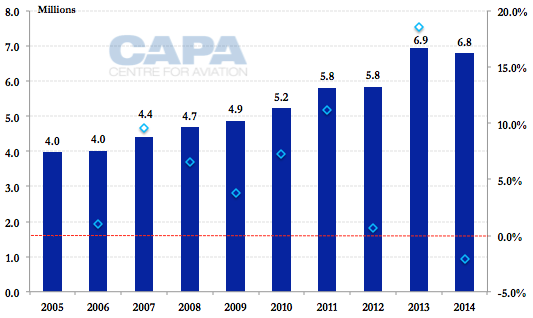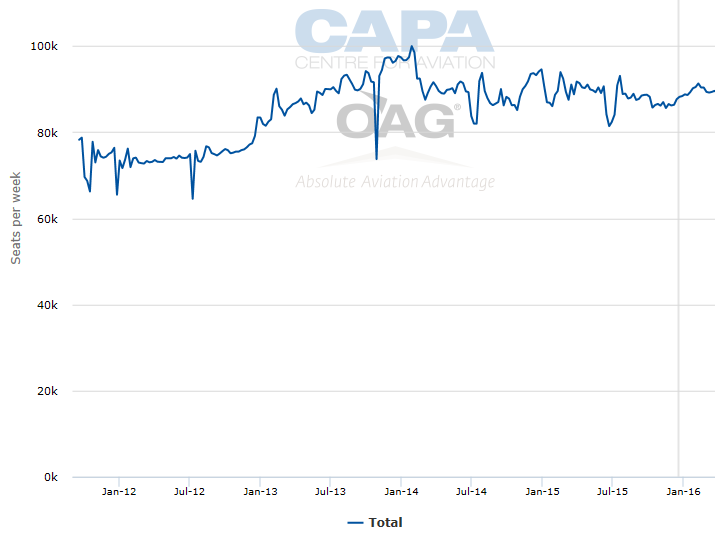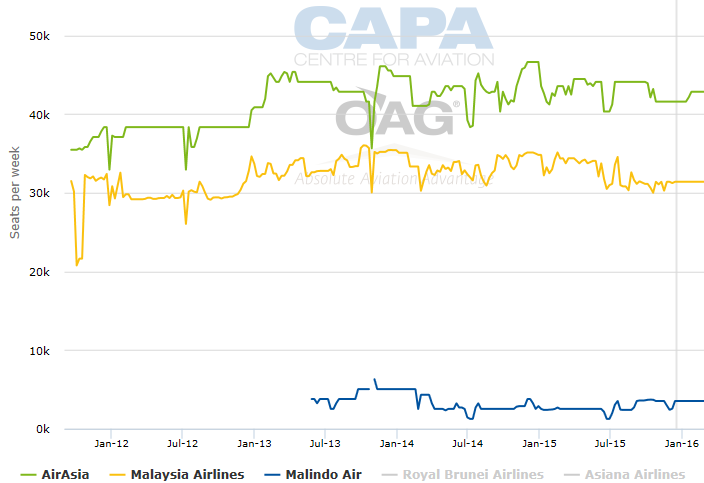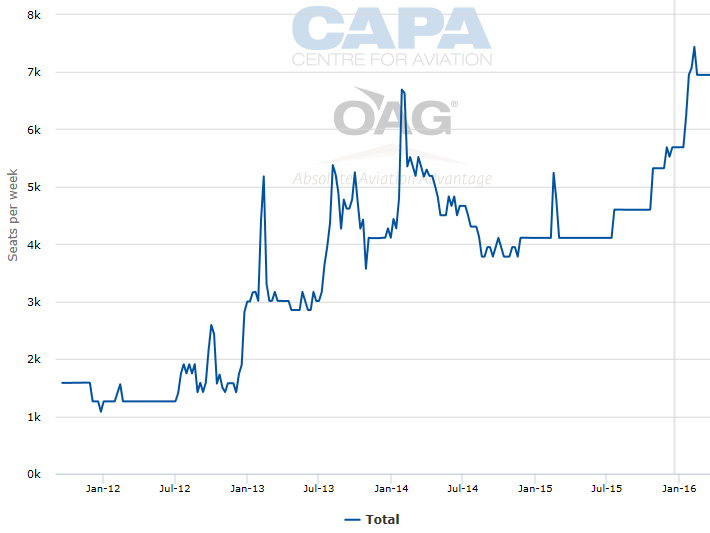Malaysia’s Kota Kinabalu Airport poised for renewed growth as Sabah-China market booms
Kota Kinabalu Airport in east Malaysia should see a resumption of traffic growth in 2016 following two years of reductions. Malaysia's second largest airport is quietly emerging as an international hub, fuelled by growth from mainland China.
Malaysia Airlines is opening a base at Kota Kinabalu in Apr-2016, which is expected to lead to nearly 30% traffic growth at the airport for the newly restructured flag carrier. AirAsia is also expanding at Kota Kinabalu in 2016, starting with a new daily service to Wuhan, its fourth Chinese route.
Kota Kinabalu also has seen the launch or resumption of service from three Chinese carriers in 2H2015. China is now the airport's largest international market and will see further growth in 2016 driven by new flights from AirAsia, Malaysia Airlines and Chinese carriers.
Kota Kinabalu passenger traffic has increased 70% since 2006 but dropped in 2014
Kota Kinabalu is the second largest airport in Malaysia and was the 15th largest in Southeast Asia based on 2014 passenger numbers. Kota Kinabalu is the main city in east Malaysia and is the capital of the Malaysian state of Sabah.
Passenger traffic at Kota Kinabalu Airport (BKI) dropped by 2% in 2014 to 6.8 million, ending at least eight consecutive years of growth. A record 6.9 million passengers were handled in 2013. Passenger traffic has increased by about 70% since 2006, when Kota Kinabalu handled slightly over 4 million passengers.
Kota Kinabalu annual passenger traffic and year over year growth: 2005 to 2014
Malaysia Airports only provides monthly traffic data for its flagship airport, Kuala Lumpur International (KLIA), and the entire network. It does not provide monthly data for Kota Kinabalu or on any other secondary airport in its portfolio.
But capacity levels have slightly decreased at Kota Kinabalu in 2015, which indicates the airport could report another slight drop in annual passenger traffic.
Kota Kinabalu capacity has declined in 2015
Across the Malaysia Airports portfolio passenger traffic was up only 0.7% through the first 11 months of 2015. Traffic at KLIA through the first 11 months of 2015 was flat at 44.1 million passengers while the rest of the Malaysia Airports portfolio collectively saw a 1.7% increase to 31.5 million passengers.
There are currently about 175,000 weekly seats at Kota Kinabalu, based on CAPA and OAG data. This represents about a 6% reduction in seat capacity compared to late Dec-2014. Kota Kinabalu capacity levels fluctuate significantly depending on the season but generally year over year capacity has been flat or slightly down throughout 2015.
Kota Kinabalu capacity (one-way seats per week): Sep-2011 to Mar-2015
The Malaysia Airlines Group currently has about 63,000 weekly seats at Kota Kinabalu, giving it a 36% share of total capacity. This includes slightly over 40,000 weekly seats from Malaysia Airlines mainline. The remaining approximately 22,000 weekly seats are provided by regional subsidiary MASwings, which is headquartered in Kota Kinabalu and operates an all-turboprop fleet purely within east Malaysia.
AirAsia is the market leader at Kota Kinabalu with about 86,000 weekly seats, giving it about a 49% share of total capacity. The group's Malaysian short haul subsidiary currently operates an average of 33 daily flights from Kota Kinabalu to eight domestic and seven international destinations. AirAsia's Philippine affiliate also operates four weekly flights to Kota Kinabalu from Manila while its Indonesian affiliate operates three weekly flights from Bali, giving the group a total of nine international destinations.
Kota Kinabalu capacity share (% of seats) by group: 14-Dec-2015 to 20-Dec-2015
AirAsia has about 34 daily flights from Kota Kinabalu compared 18 for Malaysia Airlines
AirAsia has an average of 25 to 26 daily domestic flights from Kota Kinabalu and 59 weekly international flights (includes 52 from Malaysia AirAsia and the seven from foreign affiliates). In comparison, Malaysia Airlines has an average of 16 daily domestic flights and 12 weekly international flights. Malaysia Airlines currently has four international routes and four domestic routes from Kota Kinabalu; it competes against AirAsia on all the domestic routes but only one of the international routes (Taipei).
MASwings also operates an average of 23 or 24 daily flights from Kota Kinabalu on 11 domestic routes, but using much smaller aircraft (ATR 72s and De Havilland Twin Otters). This includes two routes which have a mix of MASwings and Malaysia Airlines mainline operated flights, resulting in 13 total domestic routes for the Malaysia Airlines Group.
Both AirAsia and Malaysia Airlines have slightly reduced capacity to Kota Kinabalu over the last year. Malaysia's third main airline, Lion Group affiliate Malindo Airways, is a minor player in the Kota Kinabalu market with just three daily flights (all from Kuala Lumpur) and a 4% share of total seat capacity.
Malindo added back a third frequency about four months ago but currently has the same amount of capacity in the Kota Kinabalu market as Mar-2013, when it commenced operations and made Kuala Lumpur-Kota Kinabalu one of its initial routes. Malindo at one point had four daily flights on Kuala Lumpur-Kota Kinabalu and also briefly served Kota Kinabalu from Johor in late 2013. But the Johor-Kota Kinabalu route did not succeed and Malindo has since been focusing expansion in the Kuala Lumpur market.
AirAsia, Malaysia Airlines and Malindo Airways capacity at Kota Kinabalu (one-way seats per week): Sep-2011 to Mar-2015
Capacity growth to resume in 2016 as Malaysia Airlines opens new base
AirAsia and Malaysia Airlines are both planning to expand at Kota Kinabalu in 2016, positioning the airport for a resumption of traffic growth. Kota Kinabalu is also in the business plan for Malaysian start-up Rayani Air, which commenced operations on 20-Dec-2015 with service from Kuala Lumpur to Langkawi and is keen to join AirAsia, Malaysia Airlines and Malindo on the Kuala Lumpur-Kota Kinabalu route.
Malaysia Airlines recently unveiled plans to open crew bases in Apr-2016 in Kota Kinabalu and six other regional airports across Malaysia. As CAPA previously highlighted, Malaysia Airlines plans to introduce in Apr-2016 a new domestic schedule which will be designed to connect better with international flights operated by Malaysia Airlines, Emirates and other partners.
See related report: Malaysia Airlines post restructuring strategy evolves with Emirates partnership, new domestic bases
A large portion of Malaysia Airlines' domestic flights will be retimed and a capacity increase is also planned as the new crew bases enables the flag carrier to improve utilisation of its 737-800 fleet. At Kota Kinabalu, Malaysia Airlines expects scheduled passenger traffic to increase from about 1.7 million passengers in 2015 to about 2 million passengers in 2016 (excludes MASwings). Further growth will be generated by new charters to China, which Malaysia Airlines expects will carry about 160,000 passengers in 2016.
The additional 460,000 passengers represents 27% growth for Malaysia Airlines over its current Kota Kinabalu numbers. The 460,000 additional passengers also represents 7% growth for the airport overall. A further increase in Malaysia Airlines traffic at Kota Kinabalu is likely for 2017 as the new flights added in 2016 will be implemented in 2Q2016. There will also be more possible new flights launched in 2017, particularly if the new base performs well.
CAPA will examine the expansion and new hub plans of Malaysia Airlines for Kota Kinabalu in a separate report. This report focuses on the overall Kota Kinabalu market, including expansion from AirAsia and foreign carriers.
AirAsia grows Kota Kinabalu network in 2016 with new Wuhan route
Malaysia AirAsia also has been looking at opportunities to expand at Kota Kinabalu along with other secondary Malaysian cities. The LCC has been evaluating several potential new domestic point to point routes as well as new routes connecting secondary Malaysian airports with mainland China.
See related report: Malaysia AirAsia to focus growth from secondary hubs as Langkawi-Hong Kong, Guangzhou are launched
AirAsia recently unveiled plans to launch daily service on 22-Jan-2016 from Kota Kinabalu to Wuhan, which will be its fourth Chinese destination and 10th destination overall from Kota Kinabalu. AirAsia currently operates daily flights from Kota Kinabalu to Guangzhou, Hangzhou and Shenzhen.
Its largest international route from Kota Kinabalu is Hong Kong, which is served with two daily flights. AirAsia's other five international routes from Kota Kinabalu includes one daily flight to Singapore and Taipei, four weekly flights to Manila and three weekly flights to Jakarta and Bali. (As previously mentioned, Bali is operated by Indonesia AirAsia and Manila by Philippines AirAsia.)
AirAsia could pursue further expansion from Kota Kinabalu later in 2016, particularly as its main rival plans is own expansion.
AirAsia has had a base at Kota Kinabalu for several years and currently has six A320s based at the airport. AirAsia began offering its Fly-Thru transit product at Kota Kinabalu at the end of 2014 as the group saw an opportunity to use Kota Kinabalu as an alternative hub for connections from China to Southeast Asia. As CAPA highlighted in Oct-2014:
Kota Kinabalu is located in east Malaysia, making it an ideal connection point for flights from North Asia to Southeast Asia. AirAsia currently serves five cities in greater China from Kota Kinabalu - Guangzhou, Hangzhou, Hong Kong, Shenzhen and Taipei. All these destinations are also served by AirAsia or AirAsia X from Kuala Lumpur but the flight times from Kota Kinabalu are one to two hours shorter.
AirAsia will be able to offer connections via Kota Kinabalu between Greater China and several destinations throughout Malaysia as well as Bali, Jakarta and Singapore. Load factors on Kota Kinabalu routes will likely improve and there could be enough incremental traffic to justify more capacity on existing routes as well as potentially new routes which would not be sustainable without transit traffic.
See related report: AirAsia and AirAsia X to exceed 3 million Fly-Thru transit passengers in 2014 as model evolves
AirAsia previously warned of a potential impact from the higher costs and taxes at Kota Kinabalu Terminal 1, which it moved to on 1-Dec-2015. AirAsia had operated for 12 years at Kota Kinabalu Terminal 2, a basic facility on the other side of the runway, and eventually lost a long battle against moving to the main terminal.
Malaysia Airlines clearly benefits from AirAsia being forced to move to Terminal 1 as it levels the playing field as AirAsia international passengers at Kota Kinabalu previously enjoyed about 50% lower passenger service charges. But ultimately Kota Kinabalu will still likely see growth from AirAsia with China being the main driver and expansion from Malaysia Airlines necessitating a strategic response from AirAsia.
Kota Kinabalu sees surge of new foreign airlines
In addition to the new Wuhan service from AirAsia and new charter flights from Malaysia Airlines, Kota Kinabalu's China traffic will be boosted in 2016 from recently launched services from Chinese carriers.
International capacity at Kota Kinabalu has increased by 7% over the last year to 45,000 weekly seats. The increase has been driven by the launch of services by four foreign airlines, including Korea's Jin Air and three Chinese carriers: Spring Airlines, China Southern and Shanghai Airlines.
These four carriers combined currently have almost 6,000 weekly seats to and from Kota Kinabalu, representing about 13% of the airport's total international capacity. Jin Air currently has a daily flight from Seoul, Spring four weekly flights from Shanghai, Shanghai Airlines three weekly flights from Shanghai and China Southern has three weekly flights from Guangzhou.
Jin Air launched Kota Kinabalu on 24-Dec-2014. Shanghai Airlines launched Kota Kinabalu in Jul-2015 while Spring resumed Kota Kinabalu in Oct-2015 and China Southern resumed at the beginning of Dec-2015.
Spring previously served Kota Kinabalu from Feb-2014 to Aug-2014 and China Southern from Jan-2014 to Apr-2014, according to OAG data. China Eastern also served Kota Kinabalu until early 2014 and may join its rivals in resuming service.
Several Chinese carriers reduced capacity and suspended routes to Malaysia in 2014 as visitor numbers dropped sharply following the MH370 incident. The China-Malaysia market has recovered in recent months, prompting Chinese carriers to resume suspended routes to Malaysia and in some cases launch entirely new routes. While most of this additional capacity has been allocated to Kuala Lumpur, Kota Kinabalu has also become a hot destination for the Chinese.
China emerges as Kota Kinabalu's largest international market
Kota Kinabalu will likely see more new and increased services from Chinese carriers in 2016 along with the new China flights from AirAsia and Malaysia Airlines. There will be about 7,000 weekly one-way seats in the Kota Kinabalu-China market after AirAsia launches the Wuhan service in late Jan-2016.
Kota Kinabalu to China total capacity (one way seats per week): Sep-2011 to Mar-2015
China is already the largest international market for Kota Kinabalu and currently accounts for about 25% of total international capacity.
China is the largest source market for the Sabah tourism industry, accounting for 305,000 visitors in 2014 or 31% of total visitor arrivals. Visitor arrivals from China were down 15% in 2014 but were up 87% in 2013 and will likely be up again in 2015 - with even larger increases for 2016 - as the overall Malaysia-China market has recovered. (These figures, published by Sabah Tourism, include residents of China, Hong Kong and Macau but excludes visitors to Sabah which initially arrived and cleared immigration at other Malaysian airports.)
South Korea is the third largest source market for Sabah after China and Indonesia, accounting for 106,000 visitors in 2014. But South Korea is the second biggest international market for Kota Kinabalu Airport as a large portion of Indonesian visitors arrive by road. (Malaysia shares the island of Borneo with Indonesia and Brunei.)
Korea currently accounts for 17% of international seat capacity at Kota Kinabalu. Seoul is the most competitive international route from Kota Kinabalu with service from Asiana, EastarJet and Jin Air. Asiana also has seasonal service from Busan to Kota Kinabalu.
Kota Kinabalu international capacity (seats) by country: 14-Dec-2015 to 20-Dec-2015
The four new foreign carriers has resulted in a 50% increase in the number of foreign airlines serving Kota Kinabalu, an indication of growing inbound demand particularly from China and South Korea. Of the eight existing foreign carriers in the Kota Kinabalu market two were also from South Korea (Asiana and EastarJet), one was from Hong Kong (Dragonair) and the other five from Southeast Asia (Cebu Pacific, Philippines AirAsia, Indonesia AirAsia, Royal Brunei Airlines and SilkAir).
These eight carriers' combined capacity levels have been roughly flat over the last year. Five of the carriers have not increased or decreased capacity to Kota Kinabalu; Royal Brunei Airlines and SilkAir have reduced capacity but this has been offset by an increase from EastarJet.
Foreign carrier capacity at Kota Kinabalu (one way seats per week): week of 15-Dec-2014 vs week of 14-Dec-2015
|
Airline |
Week of 15-Dec-2014 |
Week of 14-Dec-2015 |
Year over year change |
|
1,872 seats |
1,728 seats (-7.69%) |
-8% |
|
|
1,434 seats |
1,050 seats (-26.78%) |
-27% |
|
|
1,253 seats |
1,232 seats (-1.68%) |
-2% |
|
|
1,138 seats |
1,138 seats (0%) |
0% |
|
|
740 seats |
1,309 seats (76.89%) |
+77% |
|
|
720 seats |
720 seats (0%) |
0% |
|
|
540 seats |
540 seats (0%) |
0% |
|
|
537 seats |
537 seats (0%) |
0% |
|
|
n/a |
720 seats |
N/A |
|
|
n/a |
1,302 seats |
N/A |
|
|
n/a |
492 seats |
N/A |
|
|
n/a |
366 seats |
N/A |
North Asia dominates Kota Kinabalu's international offering
Jin Air, Dragonair, Royal Brunei and SilkAir are currently the only foreign carriers serving Kota Kinabalu daily. Royal Brunei is the only carrier with more than seven weekly frequencies.
Royal Brunei currently has 12 weekly flights on the very short Kota Kinabalu-Bandar Seri Bagawan route, making it the largest foreign carrier in the Kota Kinabalu market. Royal Brunei promotes Kota Kinabalu as a twin destination with Brunei, offering packages that are mainly sold in North Asia. Most of its Kota Kinabalu passengers do not originate in Brunei.
Of the 1.6 million international passengers handled by Kota Kinabalu in 2014, 69% or 1.1 million arrived on flights from North Asia. But the actual figure of North Asian passengers is likely higher given that a large share of the airport's North Asia traffic arrive on one stop flights via other Southeast Asian airports.
About 30% or about 500,000 international passengers handled by Kota Kinabalu in 2014 arrived on flights from other countries in Southeast Asia. The remaining 1% was from Australia and the Middle East. The very small number of Middle East passengers were likely carried as part of religious pilgrimage charters to Saudi Arabia.
Kota Kinabalu 2014 international passenger traffic by sector
North Asia, in particular China, is expected to be the main source of international growth in 2016 and beyond. Kota Kinabalu will also likely see a resumption of domestic traffic growth in 2016, driven in part by international passengers making domestic connections within east Malaysia. Kota Kinabalu's potential as a hub will be examined in more detail in the next part of this report.






